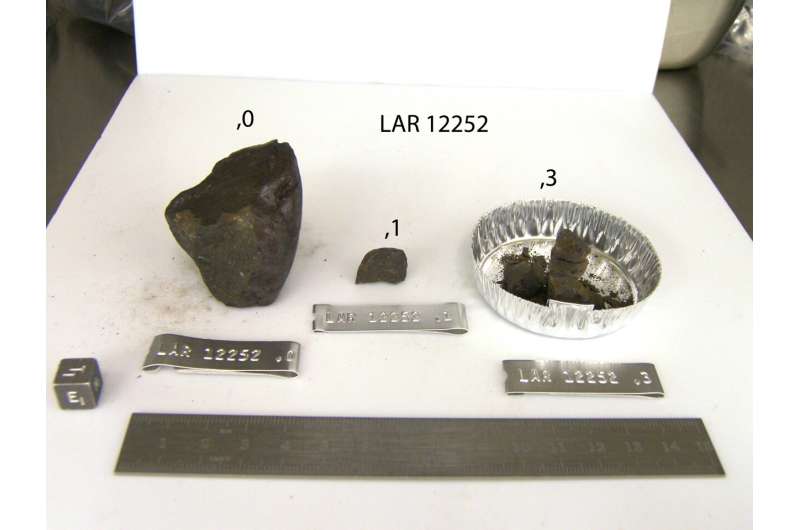A team of researchers at the University of Oxford have uncovered crucial evidence for the origin of water on Earth. Using a rare type of meteorite, known as an enstatite chondrite, which has a composition analogous to that of the early Earth (4.55 billion years ago), they have found a source of hydrogen which would have been critical for the formation of water molecules.
Crucially, they demonstrated that the hydrogen present in this material was intrinsic, and not from contamination. This suggests that the material which our planet was built from was far richer in hydrogen than previously thought.
The findings, which support the theory that the formation of habitable conditions on Earth did not rely on asteroids hitting Earth, have been published in the journal Icarus..
Without hydrogen, a fundamental elemental building-block of water, it would have been impossible for our planet to develop the conditions to support life.
The origin of hydrogen, and, by extension, water, on Earth has been highly debated, with many believing that the necessary hydrogen was delivered by asteroids from outer space during Earth’s first approximately 100 million years. But these new findings contradict this, suggesting instead that Earth had the hydrogen it needed to create water from when it first formed.

The research team analyzed the elemental composition of a meteorite known as LAR 12252, originally collected from Antarctica. They used an elemental analysis technique called X-Ray Absorption Near Edge Structure (XANES) spectroscopy at the Diamond Light Source synchrotron at Harwell, Oxfordshire.
A previous study led by a French team had originally identified traces of hydrogen within the meteorite inside organic materials and non-crystalline parts of the chondrules (millimeter-sized spherical objects within the meteorite). However, the remainder was unaccounted for—meaning it was unclear whether the hydrogen was native or due to terrestrial contamination.
The Oxford team suspected that significant amounts of the hydrogen may be attached to the meteorite’s abundant sulfur. Using the synchrotron, they shone a powerful beam of X-rays onto the meteorite’s structure to search for sulfur-bearing compounds.
When initially scanning the sample, the team focused their efforts on the non-crystalline parts of the chondrules, where hydrogen had been found before.
But when serendipitously analyzing the material just outside of one of these chondrules, composed of a matrix of extremely fine (sub-micrometer) material, the team discovered that the matrix itself was incredibly rich in hydrogen sulfide. In fact, their analysis found that the amount of hydrogen in the matrix was five times higher than that of the non-crystalline sections.
In contrast, in other parts of the meteorite that had cracks and signs of obvious terrestrial contamination (such as rust), very little or no hydrogen was present. This makes it highly unlikely that the hydrogen sulfide compounds detected by the team originated from an earthly source.

Since the proto-Earth was made of material similar to enstatite chondrites, this suggests that by the time the forming planet had become large enough to be struck by asteroids, it would have amassed enough reserves of hydrogen to explain Earth’s present-day water abundance.
Tom Barrett, DPhil student in the Department of Earth Sciences at the University of Oxford, who led the study, said, “We were incredibly excited when the analysis told us the sample contained hydrogen sulfide—just not where we expected.
“Because the likelihood of this hydrogen sulfide originating from terrestrial contamination is very low, this research provides vital evidence to support the theory that water on Earth is native—that it is a natural outcome of what our planet is made of.”
Co-author Associate Professor James Bryson (Department of Earth Sciences, University of Oxford) added, “A fundamental question for planetary scientists is how Earth came to look like it does today.
“We now think that the material that built our planet—which we can study using these rare meteorites—was far richer in hydrogen than we thought previously. This finding supports the idea that the formation of water on Earth was a natural process, rather than a fluke of hydrated asteroids bombarding our planet after it formed.”
More information:
Thomas J. Barrett et al,The source of hydrogen in earth’s building blocks, Icarus (2025). DOI: 10.1016/j.icarus.2025.116588
Citation:
Scientists find evidence that challenges theories of the origin of water on Earth (2025, April 15)
retrieved 16 April 2025
from https://phys.org/news/2025-04-scientists-evidence-theories-earth.html
This document is subject to copyright. Apart from any fair dealing for the purpose of private study or research, no
part may be reproduced without the written permission. The content is provided for information purposes only.

